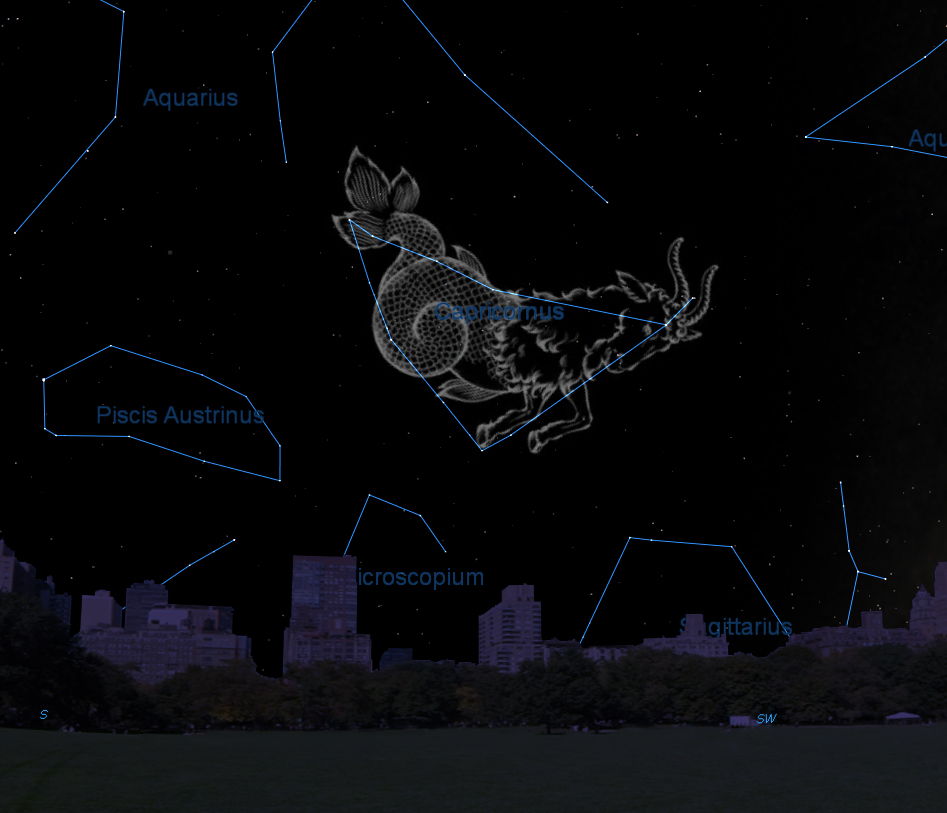How to See a Space Goat: Capricornus Constellation Explained

At this time of the year, with the major league baseball playoffs in full swing and the World Series right around the corner, I occasionally find myself thinking about the legendary sports cartoonist, Bill Gallo.
It might seem strange to start off a column on stargazing in this way, but let me explain:
Gallo, who passed away last year at the age of 88, wrote for many years in the "New York Daily News" and his daily cartoons were one of the highlights of the paper. But it was during the World Series that Gallo's cartoons would get a lot of attention.
After each game, he would sketch caricatures of two ballplayers: the hero and the "goat." Gallo would draw a pair of overly large goat horns protruding from out of the head of the unlucky player who got the goat designation.
Many ballplayers playing in the Series would often remark that they didn't want to appear in Gallo's column the next day wearing those goat horns.
It seems rather appropriate, then, that during this month of October, a star pattern that is usually identified with a goat is well-placed for viewing in our evening sky, situated due south at around 9 p.m. local daylight time. That pattern is the constellation Capricornus. [Best Night Sky Sights of October (Video)]
Half goat, half fish?
Breaking space news, the latest updates on rocket launches, skywatching events and more!
In Latin, Capricornus literally means, "horned goat." You may have heard of the famous little island of Capri in Italy — its name means that it is the island of goats. But in the old star atlases Capricornus is depicted by the figure of a sea-goat, combining the forequarters and head of a goat and the tail of a fish.
Indeed, it appears that in creating Capricornus, the imaginations of the ancient stargazers were working on overtime. This kind of weird creature might seem totally unintelligible to us today if we did not know the ancient myth that attempts to explain its origin.
The folklore behind Capricornus is rather amusing. Supposedly, there were some sea nymphs and goddesses having a wild party in a field one day when the mischievous god, Pan, saw them and joined in the fun. About this same time, however, a huge, ferocious monster called Typhon suddenly appeared.
To escape Typhon, each god changed himself into an animal and fled. However, in Pan's alarm (hence the word "panic"), he jumped into a nearby river before completing his transformation into a goat. As a result, his lower extremities assumed the form of a fish! Zeus, who just happened to be passing by, saw Pan's feat and was so amused that he decreed the perpetuation of this grotesque figure in our night sky.
It should also be emphasized to newcomers of astronomy that the currently accepted name of this constellation is Capricornus, and not Capricorn. Principally astrologers (and some older astronomy books) use the latter for labeling the zodiacal sign of that name.
But, quite frankly, Capricornus is such a faint constellation, if it were not a zodiacal sign most people would not even know its name.
Open to interpretation
The fourth-magnitude star Algiedi in the constellation is really a pair of stars (called Alpha 1 and Alpha 2) so widely separated that they can be easily distinguished without any optical aid. Astronomers have discovered that each star has a small companion of its own, so when you look at Algiedi you're actually seeing the combined light of four stars.
Interestingly, the two bright stars are not physically connected. Alpha 2 is about 100 light-years away, while Alpha 1 is about five times more distant. Below Algiedi is the third-magnitude star Dabih, also a pair, though binoculars are needed to see the seventh-magnitude companion of the brighter star. Below Dabih is a charming little trio of tiny stars: Rho, Pi and Omicron, which make for a pretty sight in binoculars.
H.A. Rey (1898-1977) managed to turn the dim stars of Capricornus into a fairly convincing looking goat. Although mythology tells us that Capricornus is a sea-goat, to most people it looks more like a roughly triangular figure, which may suggest an inverted cocked hat, or maybe a bird flying toward you.
Or, perhaps keeping in the spirit of the watery nature of this part of the sky – which is inhabited by fishes, a whale, a river and a water carrier, some might even try to envision Capricornus as the south end of a bikini!
Joe Rao serves as an instructor and guest lecturer at New York's Hayden Planetarium. He writes about astronomy for The New York Times and other publications, and he is also an on-camera meteorologist for News 12 Westchester, New York.

Joe Rao is Space.com's skywatching columnist, as well as a veteran meteorologist and eclipse chaser who also serves as an instructor and guest lecturer at New York's Hayden Planetarium. He writes about astronomy for Natural History magazine, Sky & Telescope and other publications. Joe is an 8-time Emmy-nominated meteorologist who served the Putnam Valley region of New York for over 21 years. You can find him on Twitter and YouTube tracking lunar and solar eclipses, meteor showers and more. To find out Joe's latest project, visit him on Twitter.
